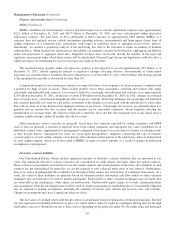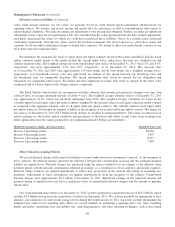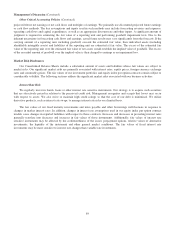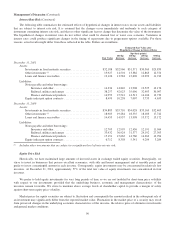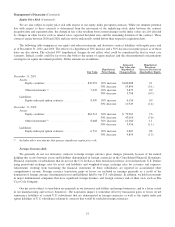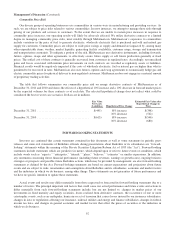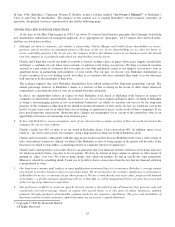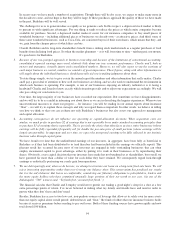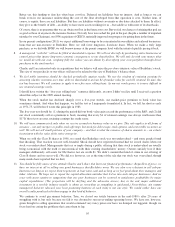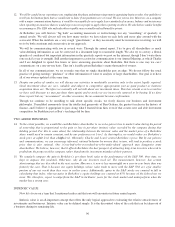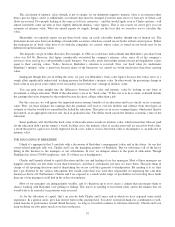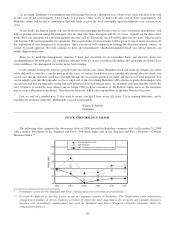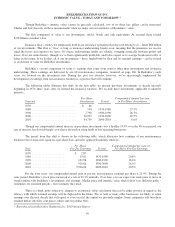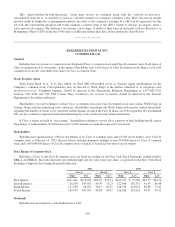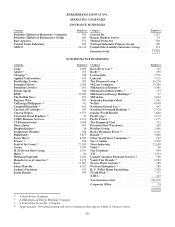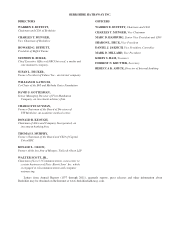Berkshire Hathaway 2011 Annual Report Download - page 99
Download and view the complete annual report
Please find page 99 of the 2011 Berkshire Hathaway annual report below. You can navigate through the pages in the report by either clicking on the pages listed below, or by using the keyword search tool below to find specific information within the annual report.The calculation of intrinsic value, though, is not so simple. As our definition suggests, intrinsic value is an estimate rather
than a precise figure, and it is additionally an estimate that must be changed if interest rates move or forecasts of future cash
flows are revised. Two people looking at the same set of facts, moreover – and this would apply even to Charlie and me – will
almost inevitably come up with at least slightly different intrinsic value figures. That is one reason we never give you our
estimates of intrinsic value. What our annual reports do supply, though, are the facts that we ourselves use to calculate this
value.
Meanwhile, we regularly report our per-share book value, an easily calculable number, though one of limited use. The
limitations do not arise from our holdings of marketable securities, which are carried on our books at their current prices. Rather
the inadequacies of book value have to do with the companies we control, whose values as stated on our books may be far
different from their intrinsic values.
The disparity can go in either direction. For example, in 1964 we could state with certitude that Berkshire’s per-share book
value was $19.46. However, that figure considerably overstated the company’s intrinsic value, since all of the company’s
resources were tied up in a sub-profitable textile business. Our textile assets had neither going-concern nor liquidation values
equal to their carrying values. Today, however, Berkshire’s situation is reversed: Now, our book value far understates
Berkshire’s intrinsic value, a point true because many of the businesses we control are worth much more than their carrying
value.
Inadequate though they are in telling the story, we give you Berkshire’s book-value figures because they today serve as a
rough, albeit significantly understated, tracking measure for Berkshire’s intrinsic value. In other words, the percentage change in
book value in any given year is likely to be reasonably close to that year’s change in intrinsic value.
You can gain some insight into the differences between book value and intrinsic value by looking at one form of
investment, a college education. Think of the education’s cost as its “book value.” If this cost is to be accurate, it should include
the earnings that were foregone by the student because he chose college rather than a job.
For this exercise, we will ignore the important non-economic benefits of an education and focus strictly on its economic
value. First, we must estimate the earnings that the graduate will receive over his lifetime and subtract from that figure an
estimate of what he would have earned had he lacked his education. That gives us an excess earnings figure, which must then be
discounted, at an appropriate interest rate, back to graduation day. The dollar result equals the intrinsic economic value of the
education.
Some graduates will find that the book value of their education exceeds its intrinsic value, which means that whoever paid
for the education didn’t get his money’s worth. In other cases, the intrinsic value of an education will far exceed its book value,
a result that proves capital was wisely deployed. In all cases, what is clear is that book value is meaningless as an indicator of
intrinsic value.
THE MANAGING OF BERKSHIRE
I think it’s appropriate that I conclude with a discussion of Berkshire’s management, today and in the future. As our first
owner-related principle tells you, Charlie and I are the managing partners of Berkshire. But we subcontract all of the heavy
lifting in this business to the managers of our subsidiaries. In fact, we delegate almost to the point of abdication: Though
Berkshire has about 270,000 employees, only 24 of these are at headquarters.
Charlie and I mainly attend to capital allocation and the care and feeding of our key managers. Most of these managers are
happiest when they are left alone to run their businesses, and that is customarily just how we leave them. That puts them in
charge of all operating decisions and of dispatching the excess cash they generate to headquarters. By sending it to us, they
don’t get diverted by the various enticements that would come their way were they responsible for deploying the cash their
businesses throw off. Furthermore, Charlie and I are exposed to a much wider range of possibilities for investing these funds
than any of our managers could find in his or her own industry.
Most of our managers are independently wealthy, and it’s therefore up to us to create a climate that encourages them to
choose working with Berkshire over golfing or fishing. This leaves us needing to treat them fairly and in the manner that we
would wish to be treated if our positions were reversed.
As for the allocation of capital, that’s an activity both Charlie and I enjoy and in which we have acquired some useful
experience. In a general sense, grey hair doesn’t hurt on this playing field: You don’t need good hand-eye coordination or well-
toned muscles to push money around (thank heavens). As long as our minds continue to function effectively, Charlie and I can
keep on doing our jobs pretty much as we have in the past.
97


